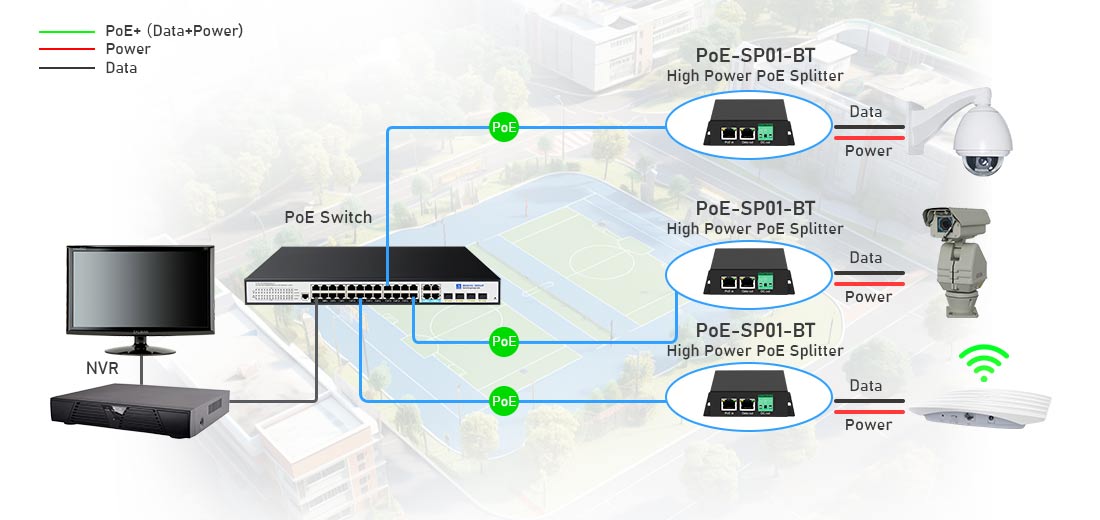
Un séparateur POE extrait la puissance et les données d'un câble Ethernet compatible POE et convertit la puissance en une tension inférieure (par exemple, 5V, 9V, 12V ou 24V) pour prendre en charge les appareils non POE. Vous trouverez ci-dessous un guide étape par étape sur la façon de connecter un séparateur POE à votre réseau et à votre appareil.
1. Composants requis
Avant de vous installer, assurez-vous d'avoir ce qui suit:
--- Poe Source - A Interrupteur POE ou injecteur POE (doit correspondre à la norme POE requise).
--- Poe Splitter - prend en charge la sortie de sortie correcte (par exemple, 12V pour une caméra IP).
--- Câbles Ethernet - Cat5e, Cat6 ou mieux (la limite de longueur standard est de 100 m).
--- Département non-POE - L'appareil nécessitant une alimentation (par exemple, une caméra IP, un point d'accès ou un convertisseur multimédia).
2. Étapes de connexion
Étape 1: Connectez le séparateur POE au réseau PoE
--- Branchez une extrémité d'un câble Ethernet dans le commutateur POE ou l'injecteur POE.
--- Connectez l'autre extrémité du câble Ethernet au port d'entrée PoE sur le séparateur.
--- Ce câble transporte à la fois l'alimentation et les données de la source PoE.
Étape 2: Connectez le séparateur à l'appareil non-POE
Le séparateur POE a deux connexions de sortie:
--- Sortie Ethernet (données uniquement, RJ45) - Connectez-le au port réseau de votre appareil non POE.
--- Sortie de sortie CC (prise de baril ou fils de borne) - branchez-le sur l'entrée d'alimentation de votre appareil.
--- Assurez-vous que la sortie de tension du séparateur correspond aux besoins d'entrée de votre appareil (par exemple, si votre caméra IP nécessite 12 V CC, définissez le séparateur sur 12V si elle est réglable).
Étape 3: Alimentation du système
--- Une fois toutes les connexions établies, l'interrupteur ou l'injecteur POE enverra automatiquement l'alimentation via le câble Ethernet.
--- Le séparateur extrait la puissance et envoie la tension correcte à l'appareil, tandis que les données se poursuivent via la connexion Ethernet.
3. Diagramme de la connexion du séparateur POE
Interrupteur POE / injecteur → Séparateur de Poe → Appareil non POE
4. Exemple d'applications
Utilisation d'un séparateur POE pour différents appareils
| Type d'appareil | Sortie de séparation POE recommandée | Remarques de connexion |
| Caméra IP (non-POE) | 12V DC, 1A | Utilisez la puissance Ethernet et DC du séparateur. |
| Point d'accès Wi-Fi (non-POE) | 9V ou 12V DC | Connectez le port RJ45 au port LAN de l'AP. |
| Raspberry Pi / IoT Dispositif | 5V DC, 2A | Utilisez un câble adaptateur USB si nécessaire. |
| Convertisseur multimédia | 12V ou 24V DC | Connectez l'Ethernet pour les données et l'alimentation CC pour le fonctionnement. |
5. Conseils de dépannage
L'appareil ne s'allume pas?
--- Vérifiez si le commutateur / l'injecteur POE fonctionne (essayez un autre port).
--- Assurez-vous que la tension correspond aux besoins en dispositif (la mauvaise tension peut provoquer une défaillance).
--- Utilisez un câble Ethernet compatible (CAT5E ou supérieur) pour assurer une bonne alimentation.
Problèmes de connexion réseau?
--- Si l'appareil n'obtient pas d'adresse IP, confirmez que la connexion Ethernet est sécurisée.
--- Utilisez un séparateur POE compatible Gigabit si votre appareil nécessite des vitesses de 1 Gbit / s.
6. Conclusion
La connexion d'un séparateur POE est simple:
1. Connectez l'entrée POE à un commutateur ou un injecteur POE.
2. Connectez l'Ethernet et les sorties de puissance du séparateur à l'appareil non-POE.
3. Vérifiez que le réglage de tension correspond aux besoins de l'appareil.
Avec cette configuration, vous pouvez alimenter et réseauter efficacement les caméras IP, les APS Wi-Fi, les convertisseurs multimédias et les appareils IoT à l'aide d'un seul câble Ethernet!